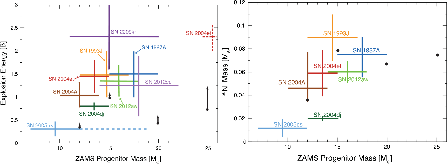Multidimensional simulations of core-collapse supernovae and
- Oak Ridge National Lab. (ORNL), Oak Ridge, TN (United States). Physics Division; Univ. of Tennessee, Knoxville, TN (United States). Dept. of Physics and Astronomy
- Univ. of Tennessee, Knoxville, TN (United States). Dept. of Physics and Astronomy
- Florida Atlantic Univ., Boca Raton, FL (United States). Dept. of Physics
- Oak Ridge National Lab. (ORNL), Oak Ridge, TN (United States). National Center for Computational Sciences; Oak Ridge National Lab. (ORNL), Oak Ridge, TN (United States). Physics Division
- Univ. of Tennessee, Knoxville, TN (United States). Dept. of Physics and Astronomy; Oak Ridge National Lab. (ORNL), Oak Ridge, TN (United States). Joint Inst. for Computational Sciences
- North Carolina State Univ., Raleigh, NC (United States). Dept. of Physics
- Oak Ridge National Lab. (ORNL), Oak Ridge, TN (United States). Computer Science & Mathematics Division
- National Science Foundation (NSF), Arlington, VA (United States). Physics Division
Core-collapse supernovae (CCSNe), the culmination of massive stellar evolution, are the principle actors in the story of our elemental origins. Our understanding of these events, while still incomplete, centers around a neutrino-driven central engine which is highly hydrodynamically-unstable. Simulations of increasing sophistication show a shock that stalls for hundreds of milliseconds before reviving. Though brought back to life by neutrino heating, the development of the supernova explosion is inextricably linked to three dimensional fluid flows. Regrettably, much of our understanding of the nucleosynthesis that occurs in these explosions, and their impact on galactic chemical evolution, is based on spherically symmetric simulations with parameterized explosions, ignoring much that has been learned about the central engine of these supernovae over the past two decades. Here in this paper we discuss recent results from two-dimensional CCSN simulations using our CHIMERA code, as well as ongoing three-dimensional simulations, and discuss how the multidimensional character of the explosions directly impacts the nucleosynthesis and other observables of core-collapse supernovae.
- Research Organization:
- Oak Ridge National Lab. (ORNL), Oak Ridge, TN (United States)
- Sponsoring Organization:
- USDOE Office of Science (SC), Nuclear Physics (NP)
- Grant/Contract Number:
- AC05-00OR22725; OCI-0749242; OCI-0749204; OCI-0749248
- OSTI ID:
- 1495964
- Journal Information:
- PoS Proceedings of Science, Vol. 204, Issue 019; ISSN 1824-8039
- Publisher:
- SISSACopyright Statement
- Country of Publication:
- United States
- Language:
- English
Similar Records
The development of explosions in axisymmetric ab initio core-collapse supernova simulations of 12–25 M⊙ stars
Comparison of the Core-collapse Evolution of Two Nearly Equal-mass Progenitors



